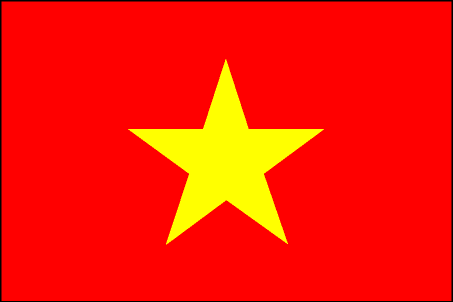
Although the Vietnamese flag looks relatively plain, there is a lot of symbolism in the star. The five points on the star symbolise: farmers, workers, intellectuals, youth and soldiers. The five points can also be related back to French colonial occupation, representing the five protectorates of the Union of French Indochina. The red background symbolises the blood from the violence in the class struggle between the working class and upper class. This particular flag was introduced in 1955.
http://www.cia.gov/cia/publications/factbook/flags/vm-flag.html
http://www.vietnam-minnesota.org/vnflag.html
![]()
The population density of Vietnam is as follows: 203 persons/km². 78% of the population live in rural areas, while 22% live in urban areas.
![]()
Like the majority of Asian currencies, one unit of the currency is worth a ridiculously small amount of money in Australian dollars. As of the 1st November, one Vietnamese dong was worth 0.0001228 Australian dollars. A$1 equals approximately 8 860 dong. In Vietnam, 1 dong is worth 10 hau and 100 xu.
![]()
Although Vietnamese is the official language of the country, many people speak other languages. These include: French, English, Chinese and Russian - all of which are the country's unofficial languages.
![]()
The Vietnamese climate is classified as tropical. Ho Chi Minh City is hot all year round and has a temperature range of 21°C - 36°C. Vietnam is well known for its rainy (monsoon) season, which occurs from May to October. The rains at this time of year are characterised by many minute-long downpours. The best time to visit depends on personal preference.
![]()
Leaders across the country call the country a "republic and dictatorship of the working class". Practically, however, it is a communism. The highest level of the government, the Politburo, consists of 15 members which make all of the country's policies. Below that, the national assembly, consisting of 496 members, endorses the laws and policies created by the Politburo. Separate from those two levels, the Council of State deals with national defence and execution of laws. Basically, the communist party chooses, the National Assembly elects. Vietnam is divided into 36 provinces, each of which has a local government. The government's army, the PAVN, consists of roughly 1 100 000 people.
![]()
Vietnamese flora and fauna is richly diversified. The main reasons for this are monsoonal tropical rains, sunshine and the convergence of many air and water currents bringing different types of seeds. There are about 200 species of animals, 800 species of birds, 100 species of amphibians and over 150 species of reptiles. In the forests, animals such as monkeys, langurs, gibbons, wild cats and squirrels can be found. Birds such as pheasants and reptiles such as snakes and chameleons are also found in the forest.

